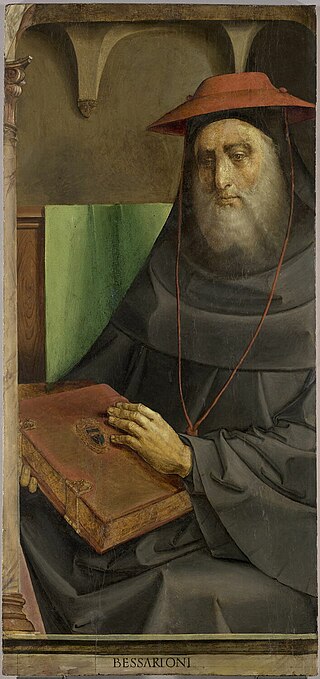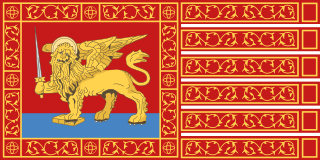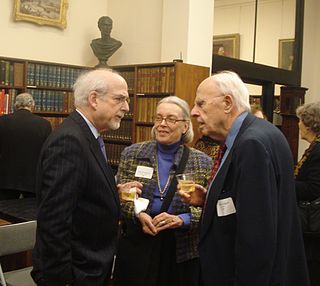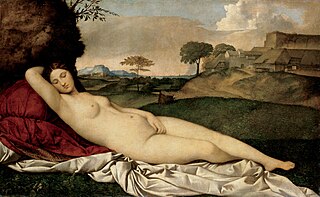Related Research Articles

Francesco I Sforza was an Italian condottiero who founded the Sforza dynasty in the duchy of Milan, ruling as its (fourth) duke from 1450 until his death. In the 1420s, he participated in the War of L'Aquila and in the 1430s fought for the Papal States and Milan against Venice. Once war between Milan and Venice ended in 1441 under mediation by Sforza, he successfully invaded southern Italy alongside René of Anjou, pretender to the throne of Naples, and after that returned to Milan. He was instrumental in the Treaty of Lodi (1454) which ensured peace in the Italian realms for a time by ensuring a strategic balance of power. He died in 1466 and was succeeded as duke by his son, Galeazzo Maria Sforza. While Sforza was recognized as duke of Milan, his son Ludovico would be the first to have formal investiture under the Holy Roman Empire by Maximilian I in 1494.

Bessarion was a Byzantine Greek Renaissance humanist, theologian, Catholic cardinal and one of the famed Greek scholars who contributed to the so-called great revival of letters in the 15th century.

ManuelChrysoloras was a Byzantine Greek classical scholar, humanist, philosopher, professor, and translator of ancient Greek texts during the Renaissance. Serving as the ambassador for the Byzantine emperor Manuel II Palaiologos in medieval Italy, he became a renowned teacher of Greek literature and history in the republics of Florence and Venice, and today he's widely regarded as a pioneer in the introduction of ancient Greek literature to Western Europe during the Late Middle Ages.

The Republic of Florence, known officially as the Florentine Republic, was a medieval and early modern state that was centered on the Italian city of Florence in Tuscany, Italy. The republic originated in 1115, when the Florentine people rebelled against the Margraviate of Tuscany upon the death of Matilda of Tuscany, who controlled vast territories that included Florence. The Florentines formed a commune in her successors' place. The republic was ruled by a council known as the Signoria of Florence. The signoria was chosen by the gonfaloniere, who was elected every two months by Florentine guild members.

The Republic of Venice or Venetian Republic was a sovereign state and maritime republic in parts of present-day Italy that existed for 1100 years from AD 697 until AD 1797. Centered on the lagoon communities of the prosperous city of Venice, it incorporated numerous overseas possessions in modern Croatia, Slovenia, Montenegro, Greece, Albania and Cyprus. The republic grew into a trading power during the Middle Ages and strengthened this position during the Renaissance. Citizens spoke the Venetian language.

Bartolomeo d'Alviano was an Italian condottiero and captain who distinguished himself in the defence of the Venetian Republic against the Holy Roman Emperor Maximilian.

The Council of Ten, or simply the Ten, was from 1310 to 1797 one of the major governing bodies of the Republic of Venice. Elections took place annually and the Council of Ten had the power to impose punishments upon patricians. The Council of Ten had a broad jurisdictional mandate over matters of state security. The Council of Ten and the Full College constituted the inner circle of oligarchical patricians who effectively ruled the Republic of Venice.

Andrea Gritti was the Doge of the Venetian Republic from 1523 to 1538, following a distinguished diplomatic and military career. He started out as a successful merchant in Constantinople and transitioned into the position of Bailo, a diplomatic role. He was arrested for espionage but was spared execution thanks to his good relationship with the Ottoman vizier. After being freed from imprisonment, he returned to Venice and began his political career. When the War of the League of Cambrai broke out, despite his lack of experience, he was given a leadership role in the Venetian military, where he excelled. After the war, he was elected Doge, and he held that post until his death.

Santorio Santorio whose real name was Santorio Santori better known in English as Sanctorius of Padua was an Italian physiologist, physician, and professor, who introduced the quantitative approach into the life sciences and is considered the father of modern quantitative experimentation in medicine. He is also known as the inventor of several medical devices. His work De Statica Medicina, written in 1614, saw many publications and influenced generations of physicians.
Renaissance humanism came much later to Germany and Northern Europe in general than to Italy, and when it did, it encountered some resistance from the scholastic theology which reigned at the universities. Humanism may be dated from the invention of the printing press about 1450. Its flourishing period began at the close of the 15th century and lasted only until about 1520, when it was absorbed by the more popular and powerful religious movement, the Reformation, as Italian humanism was superseded by the papal counter-Reformation. Marked features distinguished the new culture north of the Alps from the culture of the Italians. The university and school played a much more important part than in the South according to Catholic historians. The representatives of the new scholarship were teachers; even Erasmus taught in Cambridge and was on intimate terms with the professors at Basel. During the progress of the movement new universities sprang up, from Basel to Rostock. Again, in Germany, there were no princely patrons of arts and learning to be compared in intelligence and munificence to the Renaissance popes and the Medici. Nor was the new culture here exclusive and aristocratic. It sought the general spread of intelligence, and was active in the development of primary and grammar schools. In fact, when the currents of the Italian Renaissance began to set toward the North, a strong, independent, intellectual current was pushing down from the flourishing schools conducted by the Brethren of the Common Life. In the humanistic movement, the German people was far from being a slavish imitator. It received an impulse from the South, but made its own path.

The Marciana Library or Library of Saint Mark is a public library in Venice, Italy. It is one of the earliest surviving public libraries and repositories for manuscripts in Italy and holds one of the world's most significant collections of classical texts. It is named after St Mark, the patron saint of the city.

Bruce Milan Cole was a longtime professor of art history at Indiana University, a Senior Fellow at the Ethics and Public Policy Center in Washington, D.C., a member of the Eisenhower Memorial Commission, and the eighth Chair of the National Endowment for the Humanities.

The migration waves of Byzantine Greek scholars and émigrés in the period following the end of the Byzantine Empire in 1453 is considered by many scholars key to the revival of Greek studies that led to the development of the Renaissance humanism and science. These émigrés brought to Western Europe the relatively well-preserved remnants and accumulated knowledge of their own (Greek) civilization, which had mostly not survived the Early Middle Ages in the West. The Encyclopædia Britannica claims: "Many modern scholars also agree that the exodus of Greeks to Italy as a result of this event marked the end of the Middle Ages and the beginning of the Renaissance", although few scholars date the start of the Italian Renaissance this late.
Edward Wallace Muir Jr. is a Professor of History and Italian at Northwestern University. He is also Clarence L. Ver Steeg Professor in the Arts and Sciences and Charles Deering McCormick Professor of Teaching Excellence. Known for his use of anthropological methods in historical research, he was a pioneer in the historical study of ritual and feuding. He has been especially influential in using and interpreting microhistorical methods, which were first devised by historians in Italy. His work has focused on Renaissance Italy, especially the Republic of Venice and its territories. He is president of the American Historical Association in 2023.

The Italic League or Most Holy League was an international agreement concluded in Venice on 30 August 1454, between the Papal States, the Republic of Venice, the Duchy of Milan, the Republic of Florence, and the Kingdom of Naples, following the Treaty of Lodi a few months previously. The next forty years were marked by peace and economic expansion based on a balance of power within Italy. The decline of the League brought about the Italian Wars.
Frederic C. Lane was a historian who specialized in Medieval history with a particular emphasis on the region of Venice.
Erik Kwakkel is a Dutch scholar who specializes in medieval manuscripts, paleography, and codicology. He is a member of the Comité International de Paléographie Latine and, from 2012 through 2017, was a member of the Young Academy of the Royal Netherlands Academy of Arts and Sciences (KNAW).

The Venetian Renaissance had a distinct character compared to the general Italian Renaissance elsewhere. The Republic of Venice was topographically distinct from the rest of the city-states of Renaissance Italy as a result of their geographic location, which isolated the city politically, economically and culturally, allowing the city the leisure to pursue the pleasures of art. The influence of Venetian art did not cease at the end of the Renaissance period. Its practices persisted through the works of art critics and artists proliferating its prominence around Europe to the 19th century.

Bernardo Bembo was a Venetian humanist, diplomat and statesman. He was the father of Pietro Bembo.

The Riformatori dello studio di Padova, also Riformatori allo studio di Padova, were the three officials of the Venetian Republic responsible for overseeing education and culture. Created in 1517, initially to reopen the University of Padua after the War of the League of Cambrai, they became responsible over time for public and private schooling at all levels, public libraries in Venice and Padua, intellectual academies, and professional schools. They also reviewed and authorized for publication all books within the mainland territory of Venice.
References
- 1 2 3 4 James Bruce Ross (1976), "Venetian Schools and Teachers Fourteenth to Early Sixteenth Century: A Survey and a Study of Giovanni Battista Egnazio", Renaissance Quarterly29 (4): 521–566, esp. 528–532. doi : 10.2307/2860032
- 1 2 Paul F. Grendler, The Universities of the Italian Renaissance (Johns Hopkins University Press, 2002), pp. 138–139.